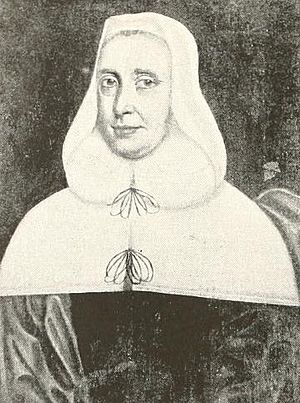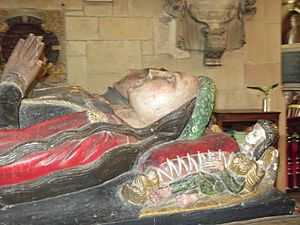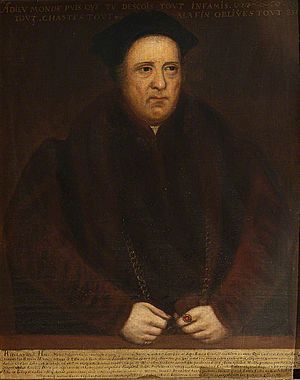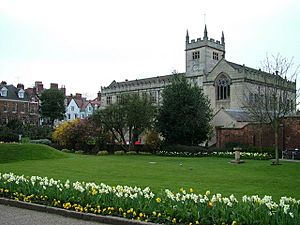Reginald Corbet facts for kids
Reginald Corbet (died 1566) was a very successful lawyer and judge in England during the mid-Tudor period. He worked under four different kings and queens and always did well. He was a Protestant and became a top lawyer called a serjeant-at-law. Later, he became a Justice of the King's Bench, which is a high court judge. He also served as a Member of Parliament (MP) for Much Wenlock in 1542 and for Shrewsbury in 1547, 1553, and 1555. Reginald Corbet became very rich, partly because his wife, Alice Gratewood, inherited a lot of money from her uncle, Sir Rowland Hill. Sir Rowland was the first Protestant Lord Mayor of London.
Contents
Who Was Reginald Corbet's Family?
Reginald Corbet was the third son of Sir Robert Corbet (who lived from about 1477 to 1513) and Elizabeth Vernon (who died in 1563). His family, the Corbet family, were important landowners. They had lived in Shropshire, near the Welsh border, for hundreds of years. Many family members had served in Parliament for Shropshire.
Reginald's mother, Elizabeth Vernon, came from powerful families too. Her father, Sir Henry Vernon, was the treasurer for Arthur Tudor, who was the Prince of Wales. Elizabeth's mother, Anne Talbot, was the daughter of John Talbot, the Second Earl of Shrewsbury. The Talbots owned huge amounts of land in England.
Reginald had two older brothers, Roger Corbet (about 1501–1538) and Richard Corbet (died 1566). Both of them also became Members of Parliament. When their father, Sir Robert, died in 1513, only Roger inherited his lands. Reginald was probably a baby when his father died, as his father's will from 1509 did not mention him or Richard. This meant Reginald had to find his own way to succeed, and he chose to study law.
How Did Reginald Corbet Become a Lawyer?
Reginald Corbet studied law at the Middle Temple, which is one of the famous law schools in London. We don't know the exact dates of his early studies. By 1552, he was a well-known lawyer and was chosen to be a "Lent Reader" at the Middle Temple. This was an important teaching role. He also helped manage the Middle Temple as an auditor in 1556 and an assistant in 1559.
Corbet likely became an MP for Wenlock in 1542 while he was still studying law. His career really started to take off around 1543. In that year, he became an official called a Feodary for Shropshire. This job involved managing lands that were under the care of the King.
Reginald Corbet's Important Marriage
In 1546, Reginald Corbet married Alice Gratewood (who died in 1603). Alice was the daughter of John Gratewood and Jane Hill. More importantly, Alice was the niece of Sir Rowland Hill. Sir Rowland was a very rich merchant from London. He made a huge fortune trading with the Netherlands. He was also the first Protestant Lord Mayor of London. Sir Rowland helped organize the translation of the Geneva Bible. Some people even think he might have inspired a character in Shakespeare's play As You Like It.
After his marriage, Reginald Corbet quickly received many important jobs. These new connections through his wife's family clearly helped his career a great deal.
Reginald Corbet's Rise as a Judge
In 1547, the year after his marriage, Corbet became the Recorder of Shrewsbury. This was a legal officer for the town, and he held this job until 1559. In the same year, he also became a justice of the peace for Shropshire. This meant he helped keep law and order. He was also a commissioner for chantries in the county. This was a key role because the new Protestant king, Edward VI, was closing down chantries (religious foundations) at that time.
In 1548, Corbet helped get a new free school started in Shrewsbury. He even paid money to bribe a servant of the Lord Chancellor to get their attention. Corbet and his friends had wanted to start this school for years. They hoped to use money from the closing of Shrewsbury Abbey. Their efforts finally paid off, and Shrewsbury School opened in 1552. It was a school with strong Protestant beliefs.
Corbet continued to get important and well-paying jobs throughout his life. These jobs were first in Shropshire, then in other areas of Wales and the Welsh borderlands. He kept getting these jobs no matter which king or queen was in power. For example, under Queen Mary's Catholic rule, he became a judge for the Quarter Sessions in many counties. In 1553, he joined the powerful Council of Wales and the Marches with his nephew, Sir Andrew Corbet. In 1558, he became a judge for the Court of Great Sessions in Wales for the northern part of Wales.
Just before Queen Mary died, she approved Corbet's appointment as a serjeant-at-law. This was a very high legal rank. The appointment was officially confirmed in April 1559, after Elizabeth I became queen and brought back Protestant rule. In October, Queen Elizabeth made him a justice of the king's bench, which is a top judge. This meant he had to resign as Recorder of Shrewsbury.
Reginald Corbet was a respected judge. His colleagues praised his clear explanations to juries. However, his time as a judge was not long, as he died in 1566.
Reginald Corbet as a Member of Parliament
Reginald Corbet was first elected as an MP for Much Wenlock in 1542. He was likely still living at the Middle Temple at the time. He was listed second after William Blount, who was the uncle of King Henry VIII's son. The people of Much Wenlock seemed to choose local important families like the Corbets to represent them.
In 1547, the town of Shrewsbury elected Corbet as their MP. This was shortly after they made him their Recorder. Corbet was the first Recorder of Shrewsbury to also be an MP. He was the lead MP for Shrewsbury, along with John Evans. This Parliament lasted a long time, until 1552. We don't know much about what Corbet did in it, except that he took time off in its last month to be a Lent Reader at the Middle Temple.
Corbet was not an MP in March 1553. The reasons are not clear. When he returned to Parliament in October 1553, during Queen Mary's reign, Shrewsbury decided that he should always be an MP as long as he was their Recorder. It's not certain if Corbet asked for this rule, and it wasn't true that Shrewsbury Recorders had always been MPs before. However, some towns did have this tradition.
Corbet was not listed among the 60 MPs who strongly opposed Queen Mary's return to Catholicism. However, when he was an MP again in 1555, he joined a group that cautiously voted against a government bill. His nephew, Sir Andrew, also voted with him.
Reginald Corbet's Family Life
Reginald Corbet married Alice Gratewood in Hodnet on August 23, 1546. Alice's uncle, Sir Rowland Hill, died in 1561 without having any children. Sir Rowland had used his huge wealth to buy many estates in Shropshire and nearby counties. Many of these lands had become available because of the Dissolution of the Monasteries (when King Henry VIII closed down monasteries). Sir Rowland left these lands to his two nieces, other family members, and for charity.
Alice inherited large estates from her uncle. This made her and Reginald Corbet very wealthy and secure for the rest of their lives. When Alice died, her estates included many manors and villages, such as Drayton, Adderley, Stoke on Tern, Hales, Almington, Blore, and Child's Ercall.
Reginald and Alice Corbet had six sons and five daughters:
- Andrew died before his father.
- Robert died before his father.
- Rowland died while he was at school.
- Francis died before his father.
- Richard (died around 1601) was Reginald Corbet's main heir. He married Anne Bromley, whose father was the Lord Chancellor Thomas Bromley.
- Their son, Sir John Corbet, 1st Baronet, of Stoke upon Tern, later strongly opposed King Charles I's policies. He sided with Parliament during the English Civil War.
- Peter married Elizabeth Pigott.
- Elizabeth married Robert Arden.
- Mary married Francis Newton.
- Anne married Edward Mytton, and then Sir William Leighton.
- Margaret married Sir Humphrey Lee.
- Jane
When Did Reginald Corbet Die?
Reginald Corbet died on November 19, 1566. This was only about four months after his brother Richard died. He had written his will the year before, and it was officially approved on January 22, 1567.
His son Richard was his heir. However, Reginald knew that his wealth mostly came from his wife's inheritance. So, in his will, he wrote that he couldn't leave his lands to anyone because his wife owned them jointly with him. He trusted her to provide for their children based on a plan he had made.
He left gifts to his family and servants. He gave a horse to his nephew Sir Andrew and another horse, a crossbow, and a silver cup to Robert Corbet, Sir Andrew's son. He asked them to be kind to Alice. He also gave a horse to his brother-in-law, William Gratewood, and forgave a debt of £14. He left a very large sum of £400 for his daughter Elizabeth's marriage, as she was still single. He was also generous to his servants, giving them a full year's pay and up to an extra year of free food and lodging while they looked for new jobs. Alice, his wife, was in charge of carrying out his will.
Images for kids
-
Richard Rich, 1st Baron Rich, Lord Chancellor from 1547 to 1552








